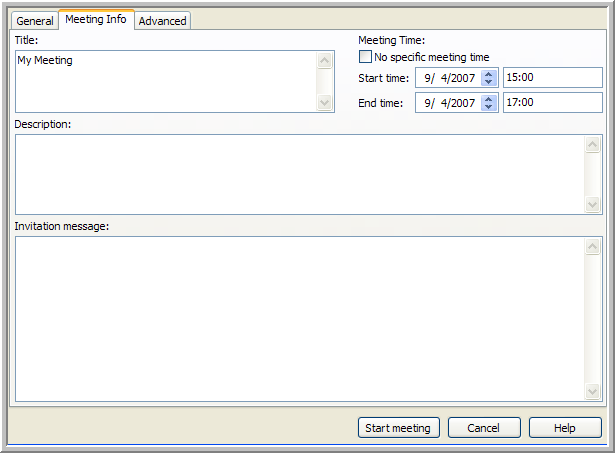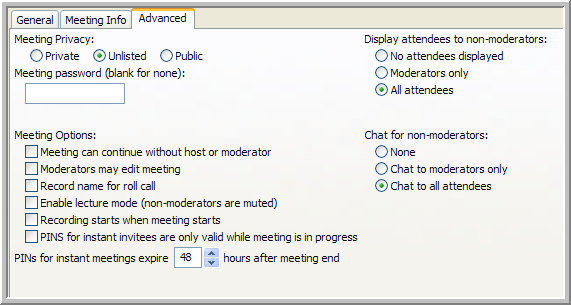3.4 Editing the Meeting Options
Meeting Options can be set in the Meeting Setup window when starting or editing a meeting, or to modify a running meeting.
NOTE: If you change meeting options when starting a meeting or for a running meeting, the new settings are only in effect for that specific meeting. When you run the meeting again, it reverts back to the last settings you saved for the meeting.
There are three tabs in the Meeting Setup window:
-
General Meeting Options: Set the meeting type, phone, e-mail, IM, and moderator options in this tab. See General Meeting Options.
-
Meeting Info Options: Set the meeting title, description, invitation message, and meeting time in this tab. See Meeting Info Options.
-
Advanced Meeting Options: Set the meeting privacy, password, advanced meeting options, display, and chat settings in this tab. See Advanced Meeting Options.
3.4.1 General Meeting Options
The following options are available on the tab of the Meeting Setup window:
Figure 3-1 General Meeting Options Tab

-
Meeting Type: This option lets the invitees know in their e-mail or IM invitation what type of meeting it is. Regardless of the setting, any meeting can share voice and data if necessary.
There are three meeting types:
-
Voice & Data Share
-
Voice Only
-
Data Share Only
-
-
Make 1-to-1 Calls When You Call One Other Person: When you select this option and call one other person, your phones are directly connected in a private sub-meeting. See Making Phone Calls for more information.
NOTE: 1-to-1 calls do not dial extensions.
Consider the following when you select this option:
-
If you are calling no other people, you are placed in a private sub-meeting by yourself.
-
If you call two or more people, a conference call is placed to all parties who are not currently on the phone.
NOTE:When you do not select this option, all calls are conference calls.
-
-
Set Phones: There are two options (buttons):
-
All: Click to call all invitees when the meeting starts.
-
None: Click to place no calls when the meeting starts.
These options override the current values in the column for all invitees. You can select each invitee's phone number individually by using this field, or select the option to manually type in a number.
NOTE:The Follow Me Phone Number is only available to Personal Buddies. As soon as a Personal Buddy’s Follow Me Phone Number changes, it immediately becomes available to you. You need to restart the client to get any updated numbers for registered users who are not Personal Buddies.
-
-
Emails: There are two e-mail options (buttons):
-
All: Click to send all invitees e-mail invitations when you schedule or start the meeting.
-
None: Click to send no e-mail invitations.
These options override the current values in the column for all invitees. You can select each invitee's e-mail address individually by using this field, or select the option to manually type in an e-mail address. The e-mail invitation the invitees receive contains a link to the meeting.
-
-
IMs: There are two IM options (buttons):
-
All: Click to send all invitees IM invitations when you start the meeting.
-
None: Click to send no IM invitations.
These options override the current values in the column for all invitees. If the invitee is a Conferencing user and is online at the time the invitation is sent, the invitee receives a pop-up invitation with a link to the meeting.
NOTE: If you are invited to two or more meetings via IM invitations before responding, you only see the last invitation. To join an ongoing meeting from a previous invitation, go to your Meeting List window and find the desired meeting.
-
-
Moderator (check box on the column): Select this option to configure an invitee as a moderator. After a meeting commences, the moderator privilege can be granted or revoked by using the menu items.
NOTE:The host of the meeting always enters the meeting with the moderator privilege regardless of how the check box is set in the meeting setup window.
3.4.2 Meeting Info Options
The following options are available from the tab:
Figure 3-2 Meeting Info Options Tab

-
Title: The meeting title is included in IM and e-mail meeting invitations and is displayed in the Meeting List window. If it is a public meeting, you might want to include your name as part of the meeting title so others know you are the host.
-
Description: A detailed description of the meeting. The description is included in IM and e-mail meeting invitations.
-
Message to Include with Invitations: An additional text description that is part of the invitation. It does not show up in the meeting list.
NOTE:If you intend to send IM invitations, it is best to keep the content of the text in title, description, and message short because IM systems limit message size.
-
Meeting Time: You can select the option to configure the meeting as a floating meeting for you and the invitees or you can select a and for the meeting.
3.4.3 Advanced Meeting Options
The following options are available on the tab:
Figure 3-3 Advanced Options Tab

-
Meeting Privacy: You have three options for privacy settings:
-
Private: Private meetings do not show up in meeting lists (unless you are an invitee or it is your own private meeting) and you cannot join anonymously (that is with a Meeting ID). You must use a valid Meeting PIN (found in your e-mail or IM invitation) to join a private meeting.
-
Public: Anyone can join a public meeting. Public meetings show up in the meeting list for all users in your community.
NOTE:If the administrator disables the display of these meetings, use the tool to view public meetings. See Administration Policies for more information.
-
Unlisted: Anyone can attend unlisted meetings, but you must know the Meeting ID in order to join the meeting. Administrators can see all unlisted meetings in their window.
NOTE:Unlisted is often the best choice for an Instant Meeting. It allows you to give the Meeting ID to people, but the meeting never appears in a user’s meeting list unless you invite the user.
-
-
Meeting Password Required: Adds an additional layer of security. When you use a meeting password, all invitees must know the password to get into the meeting. The number of digits is defined by policy. The moderator or meeting owner can view the password in the window.
-
Meeting Options: You have six meeting options:
-
Meeting Can Continue Without Moderator: Select this option to allow a meeting to remain in progress when no moderator is present. If this option is not selected, the meeting immediately ends when the last moderator leaves the meeting.
-
Moderators May Edit Meeting: Select this option to allow moderators to edit the options for a meeting after it has started.
-
Record Name For Roll Call: Select this option to prompt each invitee for their name as they join the meeting. Each invitee's name is announced as they join and when they leave the meeting.
-
Enable Lecture Mode (Non-moderators are muted): Select this option to run a meeting as a lecture. Only moderators are active participants while this option is set.
-
Enable Meeting Recording: Select this option to enable the recording of this meeting.
-
PINs For Instant Invitees are Only Valid While Meeting is in Progress: Select this option so that any invitations you send during the meeting are only valid for the current meeting. If you end the meeting and then restart it, invitations for the earlier session of the meeting are no longer valid. This does not effect invitations to users who are persistent invitees of Scheduled Meetings.
When you do not select this option, you can set an expiration time for instant invitees during which they can join any session of the meeting. For example, if you set an expiration time of 24 hours, instant invitees can join the meeting any time within that 24 hour window no matter how many times you start and stop the meeting. An expiration time of 0 hours is equivalent to invitations being valid only for the duration of the current meeting.
-
-
Display Attendees to Non-moderators: There are three display options available:
-
No Attendees Displayed: Do not show attendee names in the Meeting window to non-moderators.
-
Moderators Only: Show only the names of moderators in the meeting to non-moderators.
-
All Attendees: Show all attendee names to non-moderators.
NOTE:All attendee names are always shown to moderators, independent of this setting.
-
-
Chat For Non-moderators: There are three chat options:
-
None: Do not allow any chat for non-moderators.
-
Chat to Moderators Only: Only allow participants to chat with moderators.
-
Chat to All Attendees: Allow any participant to send a chat message to any other participant.
-